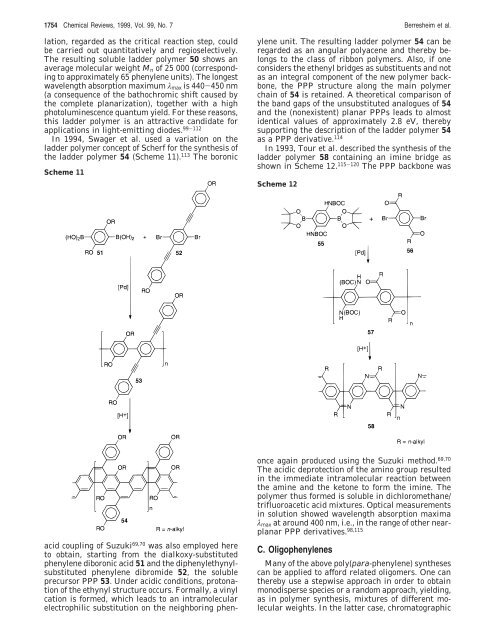Polyphenylene Nanostructures - Cluster for Molecular Chemistry
Polyphenylene Nanostructures - Cluster for Molecular Chemistry
Polyphenylene Nanostructures - Cluster for Molecular Chemistry
Create successful ePaper yourself
Turn your PDF publications into a flip-book with our unique Google optimized e-Paper software.
1754 Chemical Reviews, 1999, Vol. 99, No. 7 Berresheim et al.<br />
lation, regarded as the critical reaction step, could<br />
be carried out quantitatively and regioselectively.<br />
The resulting soluble ladder polymer 50 shows an<br />
average molecular weight Mn of 25 000 (corresponding<br />
to approximately 65 phenylene units). The longest<br />
wavelength absorption maximum λmax is 440-450 nm<br />
(a consequence of the bathochromic shift caused by<br />
the complete planarization), together with a high<br />
photoluminescence quantum yield. For these reasons,<br />
this ladder polymer is an attractive candidate <strong>for</strong><br />
applications in light-emitting diodes. 99-112<br />
In 1994, Swager et al. used a variation on the<br />
ladder polymer concept of Scherf <strong>for</strong> the synthesis of<br />
the ladder polymer 54 (Scheme 11). 113 The boronic<br />
Scheme 11<br />
acid coupling of Suzuki 69,70 was also employed here<br />
to obtain, starting from the dialkoxy-substituted<br />
phenylene diboronic acid 51 and the diphenylethynylsubstituted<br />
phenylene dibromide 52, the soluble<br />
precursor PPP 53. Under acidic conditions, protonation<br />
of the ethynyl structure occurs. Formally, a vinyl<br />
cation is <strong>for</strong>med, which leads to an intramolecular<br />
electrophilic substitution on the neighboring phen-<br />
ylene unit. The resulting ladder polymer 54 can be<br />
regarded as an angular polyacene and thereby belongs<br />
to the class of ribbon polymers. Also, if one<br />
considers the ethenyl bridges as substituents and not<br />
as an integral component of the new polymer backbone,<br />
the PPP structure along the main polymer<br />
chain of 54 is retained. A theoretical comparison of<br />
the band gaps of the unsubstituted analogues of 54<br />
and the (nonexistent) planar PPPs leads to almost<br />
identical values of approximately 2.8 eV, thereby<br />
supporting the description of the ladder polymer 54<br />
as a PPP derivative. 114<br />
In 1993, Tour et al. described the synthesis of the<br />
ladder polymer 58 containing an imine bridge as<br />
shown in Scheme 12. 115-120 The PPP backbone was<br />
Scheme 12<br />
once again produced using the Suzuki method. 69,70<br />
The acidic deprotection of the amino group resulted<br />
in the immediate intramolecular reaction between<br />
the amine and the ketone to <strong>for</strong>m the imine. The<br />
polymer thus <strong>for</strong>med is soluble in dichloromethane/<br />
trifluoroacetic acid mixtures. Optical measurements<br />
in solution showed wavelength absorption maxima<br />
λmax at around 400 nm, i.e., in the range of other nearplanar<br />
PPP derivatives. 98,115<br />
C. Oligophenylenes<br />
Many of the above poly(para-phenylene) syntheses<br />
can be applied to af<strong>for</strong>d related oligomers. One can<br />
thereby use a stepwise approach in order to obtain<br />
monodisperse species or a random approach, yielding,<br />
as in polymer synthesis, mixtures of different molecular<br />
weights. In the latter case, chromatographic

















